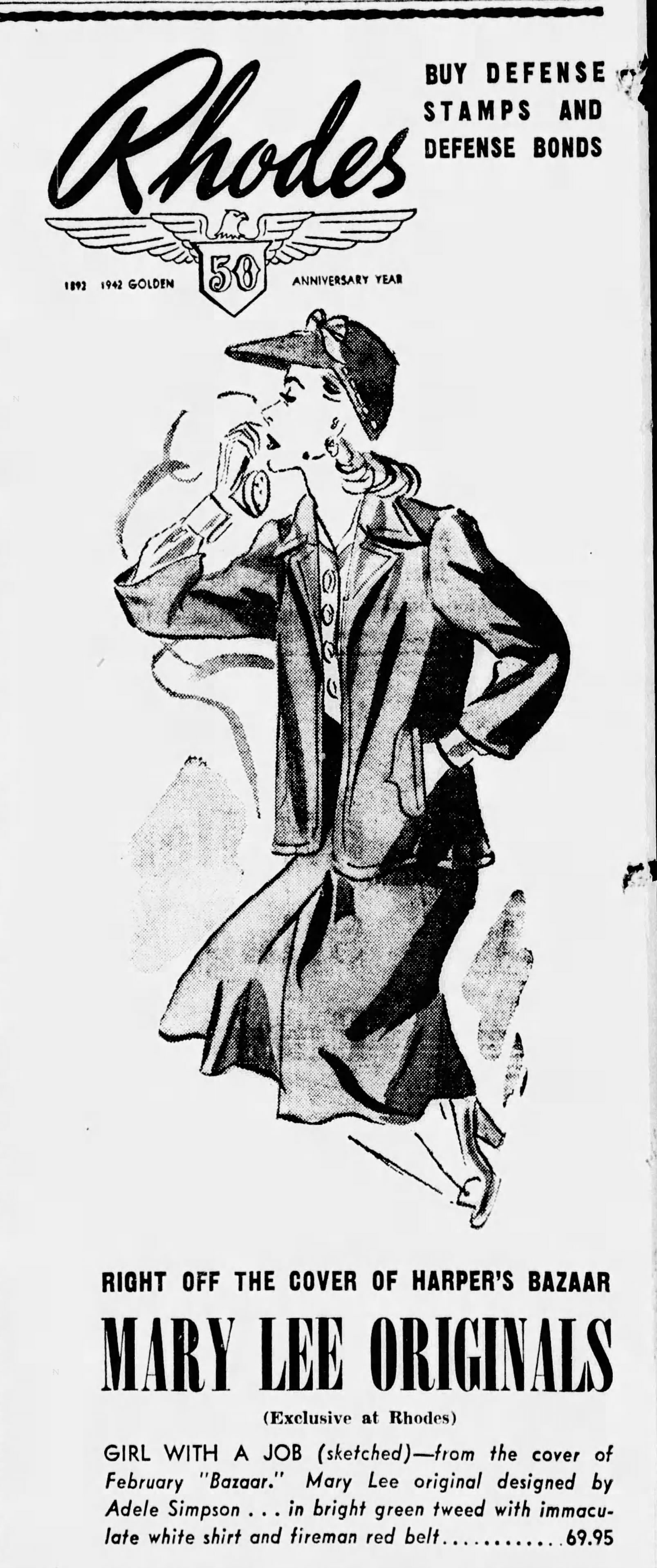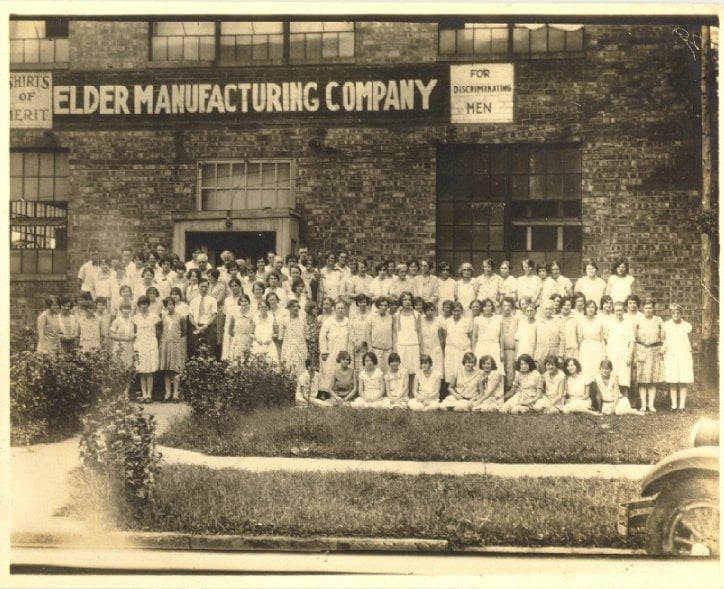What's In A Name: Mythical Labels
When someone looks at Christian Dior, Chanel, Giorgio Armani, Yves Saint Laurent, or Versace, the first thing that comes to mind after the fashions they’ve designed are the famous designers behind the names. In many of these cases, their personal lives were as well known as their fashions!
But it wasn’t always like that…and today’s post will show you why.
Many fashion houses of the past had names on their doors which had absolutely nothing to do with the designers who created their fashions. The designers were hidden….anonymous….as unknown as the jobbers who made the garments or the guys schlepping the finished goods up and down Seventh Avenue in hand trucks.
Instead, the names on their labels originated from company salesmen or production heads. Sometimes they were created from arrangements of the initials of the men who put up the money.
But sometimes - more often than you might think, really - the names on the labels bear the names of other people. Some of these people might be rich and famous, sure, but in a lot of instances, they aren’t even real people.
Jonathan Logan circle skirt, circa 1950s - Fashion Conservatory's Label Archive.
Take Jonathan Logan.
By the late 1960s, Jonathan Logan was the nation’s largest independent manufacturer of ready-to-wear women’s apparel in the United States. The company operated fourteen different brands, from Alice Stuart and Bleeker Street, to Butte and Misty Harbor.
But surprisingly, there wasn’t ever anyone named Jonathan Logan in the company. Founder David Schwartz, who entered the dress manufacturing business in the early 1920s, picked the name Jonathan Logan simply because it had a “nice sound.”
No doubt you’ve heard of Ann Taylor?
Ann Taylor’s founder, Richard Liebeskind, founded the brand in New Haven, Connecticut in 1954. Liebeskind named his enterprise after a best-selling shirtwaist dress his father (who was also in the women’s clothing business) had called the “Ann Taylor.” Liebeskind settled on that particular name because of his belief the name sounded tweedy and Ivy League-ish, exactly what the clothes he sold looked like.
Then there was Mary Lee Fashions.
Famous designer Adele Simpson, whose own label is a familiar one, designed for this old-school design house in the beginning of her career.

Rhodes "Girl With A Job" ad for Mary Lee Originals from the 8 Feb 1942 edition of The News, Tacoma, WA
Mary Lee - a company Simpson purchased in 1949 and then renamed after herself - was originally named because Mary Lee sounded like the sort of name a smart and stylish girl would have.
And Ellen Tracy?
Again, there’s no designer named Ellen Tracy, or even anyone named Ellen Tracy, behind the famous name on the label. She is nothing but a figment of the imaginations of the label’s founders, Herbert Gallen and Mike Brawer.
The pair founded Ellen Tracy in 1949 and pulled the name from Tranel, an underwear firm they bought and transformed into a women’s printed blouse company. Linda Allard took over as the label’s head designer in the 1960s, though her name wasn’t added to the label until the 1980s.
Label from an Ellen Tracy green paisley and floral print skirt - circa 1970s, Fashion Conservatory's Label Archive.
Then there were the design houses who lifted names from the registries of the rich and famous.
Industry giant Leslie Fay is one of these design houses.
Leslie Fay itself (founded in 1947 by Fred P. Pomerantz) was named after his daughter, and many of the company’s eventual dozens of divisions - Leslie Pomer, John Pomer, and Andrea Gayle among them - were also inspired by the names of family members.
Label from a Joan Leslie By Kasper green and pink plaid dress and jacket set - circa 1960s, Fashion Conservatory's Label Archive.
But the name of one of their divisions, Joan Leslie, was inspired by American actress and vaudevillian Joan Leslie and not by any of the designers or employees of the division.
Designer Herbert Kasper was actually the designer for the label.
You’ve probably never heard of the Elder Manufacturing Company of St. Louis. It was founded in 1916 as a men’s and boys’ apparel company, and still exists today as a maker and distributor of school uniforms.
You might not have even heard of the two most famous products they began to manufacture in the early 1920s through the early 1960s: one, a line of boy’s garments, and two, a line of men’s casual shirts. But you’ve most certainly heard the names the company used on their labels: Tom Sawyer and Mark Twain.

The Elder Manufacturing Company in McLeansboro, Illinois (August 1928). Photo: Flora Mayberry
To be fair, Elder Manufacturing didn’t trade fraudulently on the names we associate so closely with author Samuel Clemens. In 1918, the company licensed the Tom Sawyer name from the Mark Twain Foundation to use as the brand name for their boys’ garments.
In a similar fashion they obtained the Mark Twain trademark in 1937 from Hall, Hartwell and Co., before manufacturing any garments using that label (and incidentally, they also used the name Becky Thatcher for their girls’ lines). In 1952, Elder published notifications in many newspapers making their authorized use of the names very clear. Today, Elder Manufacturing still uses both labels for their school uniform lines.
The labels we've explored today are just a few of the labels who use names with origins other than the names of their founder or designer. As you've seen, the reasons they choose to go the fictitious route are as varied as their origin stories.
While fame and recognition may have attached themselves to designers like Calvin Klein, Perry Ellis, Ralph Lauren and Halston, it's clear having fictitious names certainly didn’t stop the companies who adopted them from achieving that same level of notoriety!
by Patricia Browning
A native of the Midwest, Patricia got her archivist degree in Information Management and Preservation at the University of Glasgow. Her lifelong fascination with research saturates nearly every aspect of her life. These days when she’s not nose-deep in research on vintage fashions and their labels, Patricia can usually be found doing genealogy or working on her pet project on David Tennant’s early theatre career in Scotland.
–SOURCES–
Advertisement. “Rhodes: Mary Lee Originals.” (8 February 1942). The News Tribune [Tacoma, WA], image 20. Newspapers.com.
Announcement. “Registration of Marks of Ownership of Personal Property.” (1 March 1952). Defiance Crescent News [Defiance, OH], p. 6, image 6. Newspaperarchive.com.
Cawthon, Frances. "It's Joan Leslie: Women Like 'Switchable' Styles." (7 March 1969). The Atlanta Journal [Atlanta, GA], image 32. Newspapers.com.
“Fred Pomerantz interview, 1981 October 29 and November 5.” YouTube. Uploaded by FIT Special Collections & College Archives, 24 August 2018. https://youtu.be/IDIBigZSIoo
Grossman Ellie. “Ann Taylor Fashions Branch Out.” (23 January 1979). Sarasota Journal [Sarasota, FL], p. 4B, image 17. Newspaperarchive.com.
Hatfield, Julie. “Ellen Tracy fans loyal to look, prices.” (28 September 1994). Syracuse Herald-Journal [Syracuse, NY], pp. B1, B4, images 13, 15. Newspaperarchive.com.
Historical Boys' Clothing. “Elder Manufacturing Company: Tom Sawyer Brand.” Histclo.com. 2005/2015.
“History: Quality from the beginning…” Elderwear We Care, Elder Manufacturing Company, 2021. https://elderwearwecare.com/about/history/
Ingrassia, Michele. “The Private Names Behind Popular Labels.” (17 November 1981). Newsday [New York, NY], images 136-7. Newspapers.com.
“John Pomerantz interview, 2017 April 19.” YouTube. Uploaded by FIT Special Collections & College Archives, 30 August 2018. https://youtu.be/_JcyENwGvaM
Klemesrud, Judy. “Jonathan Logan: Beyond Go-Go.” (26 November 1966). The New York Times [New York, NY], p. 40, image 46. TimesMachine.
Morris, Bernadine. “Fashion Designers Hide Behind Mythical Names.” (5 November 1965). Nashua Telegraph [Nashua, NH], p. 6, image 6. Newspaperarchive.com.
Robert Matzen. “Joan Leslie Obituary: Leslie And The Professor." Wordpress.com. 2015.
The Yesterdays of....Hamilton County, Illinois. “Old Photos - Elders Manufacturing Company.” Flora Mayberry’s Photo Album. Carolyar.net, 2024.
Webb City Area Genealogical Society. “Elder Mfg. was an important part of Webb City for 66 years.” (20 April 2022). Old News, Webb City Sentinel [Webb City, MO]. Webbcity.net, 2024.
Wonderclub. “Harper’s Bazaar February 1942 Magazine.”
